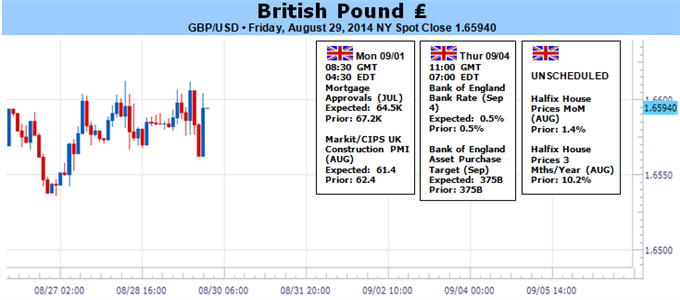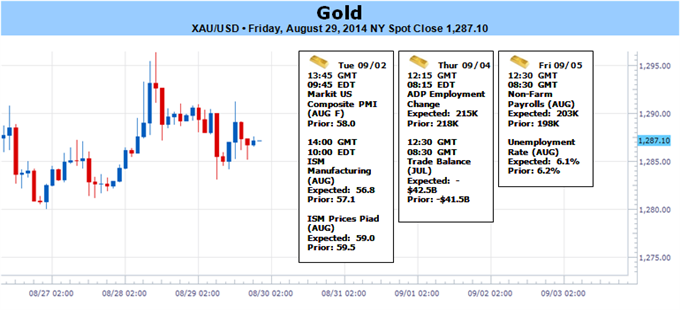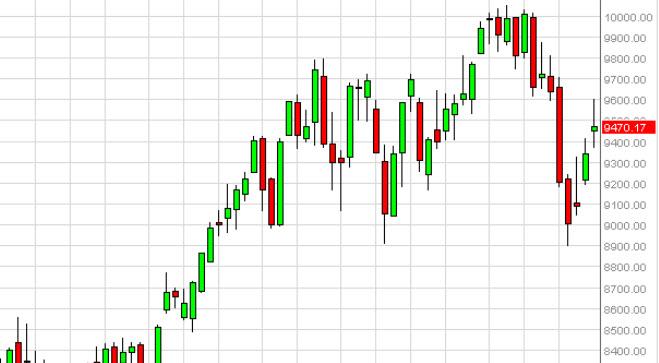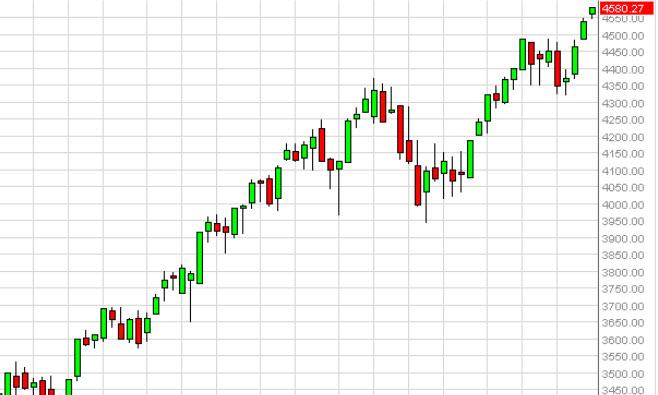Forex Weekly Outlook September 1-5
The euro was the big loser in a week that otherwise saw some profit taking on dollar longs. The first week of September is packed with top tier events as traders return from their vacations. Rate decisions in Australia, Canada, Japan, the UK, and most importantly the euro-zone, and US PMIs leading up to the all-important US NFP report; are the major events in our forex calendar. Check out these events on our weekly outlook.
It was yet another exciting week in markets, as currency action defied the summer heat. The echoes from Draghi’s Jackson Hole speech hit the euro with a gap, and it could never recover. Mediocre EZ data didn’t help. The US reported stronger growth than first estimated: 4.2% growth in Q2 (annualized). Nice consumer confidence and low jobless claims also helped the dollar. But as not all indicators were impressive, it allowed some currencies to recover: the Aussie showed resilience once again, and the loonie made a comeback. On the other hand, the yen suffered from unimpressive inflation data and the pound remained depressed.
- Australian rate decision: Tuesday, 4:30. Australia’s central bank maintained the cash rate at a record low of 2.5%, saying the nation’s economic outlook remains unclear. The slowdown in mining investment weighs on growth. Therefore, GDP expansion in the June quarter is expected to be weaker than in the previous quarter. Domestic demand is also subdued due to elevated currency. However, lenient monetary policy boosted the housing market. Global issues also contributed to uncertainty tensions in Ukraine and Gaza and the guessing game around the timing of the first rate increase in the US. No change in rats is expected now.
- US ISM Manufacturing PMI: Tuesday, 14:00. The U.S. manufacturing sector improved strongly in July reaching 57.1 points following 55.3 points in June. Economists expected a reading of 56.1. US Manufacturing remained in expansion territory for 14 consecutive months. New orders advanced to 63.4, rising 4. points from June’s reading of 58.9. Production edged up to 61.2, from 60 and the employment soared to 58.2, up 5.4 points from June’s reading of 53. A slight drop to 57 is forecasted this time.
- Australian GDP: Wednesday, 1:30. Australia’s economy expanded 1.1% in the first quarter beating expectations for a 0.9% growth rate. The high rise was explained by the unexpected growth to the mining, financial and insurance services and the construction boom. The rate of expansion in the last 12 months to March reached 3.5% indicating the economy is resilient. The RBA projects a growth rate of 2.75% for this year and a rise of 2.5% for 2015. Australia’s economy is predicted to expand 0.4% in the second quarter.
- Canadian rate decision: Wednesday, 14:00. Canada’s central bank maintained its overnight rate target at 1% as it had been since September 2010. The Bank of Canada said global economic growth was subdued until April Monetary Policy Report, but is expected to pick up in the following months. In light of the lukewarm global outlook, Canada’s GDP is expected to be weaker than previously expected. However, the softer Canadian dollar and forecast for increases in global demand, are expected to expand exports leading to higher growth rate. Real GDP growth in Canada was expected to average around 2 ¼ % in 2014-16. Rates are expected to remain unchanged.
- Rate decision in Japan: Thursday. The Bank of Japan kept its record stimulus measures to increase the monetary base at an annual pace of 60 trillion yen to 70 trillion yen, after weak releases of production and export data. Exports weakened in June as well as retail sales. Japan’s economy shrank at an annual pace of 6.8% in the second quarter due to by a sales tax hike introduced in April and GDP contracted 1.7% from the first quarter.
- Rate decision in the UK: Thursday, 11:00. Bank of England policymakers decided to leave interest rates at 0.5% in their August meeting, however, for the first time in three years, two members unexpectedly voted to tighten policy and raise interest rates to 0.75%. The BoE lowered its forecasts for wage growth for 2014 saying it did not want to raise rates until stronger wage rises occur despite a decline in the unemployment rate which may lead to wage growth. Most of the MPC members said the inflation outlook was too weak to justify a rate hike despite a positive growth rate forecast in 2014.No change is expected now.
- Rate decision in the Eurozone: Thursday 11:45, press conference at 12:30. Mario Draghi dropped the bomb in Jackson Hole, by acknowledging that low inflation is not only temporary, and that inflation expectations are falling. This raises expectations for action in September’s meeting. However, Draghi is likely to look for a wider consensus, especially from his German colleagues. In addition, the TLTROs come into effect this month, and this could lead the governing council to wait. The not too horrible inflation numbers are also a reason to wait now. Nevertheless, we can expect heavier hints about QE and more pressure to keep the euro down, if not even lower. Some also expect another rate cut, but this is unlikely now. Draghi’s words are set to rock the markets.
- US ADP Non-Farm Employment Change: Thursday, 12:15. U.S. employers hired 218,000 workers in July, posting the fourth months of private job growth beyond 200,000. However July’s reading was lower than the 234,000 reading anticipated by analysts and considerable bellow June’s rise of 281,000. Economists believe the economy will return to full employment by late 2016 if the pace of growth continues. Jobs in professional and business services increased by 61,000 in July, down from 79,000 in June, while positions in the trade, transportation and utilities category grew by 52,000 versus 56,000 in June. An addition of 216,000 jobs is expected now.
- US Trade Balance: Thursday, 12:30. The U.S. trade deficit narrowed in June to its lowest level since January contracting to a seasonally adjusted $41.5 billion, from $44.7 billion in May. The improvement occurred due to a fall in imports, led by lower shipments of cellphones, petroleum, and cars. Exports climbed 0.1% to $195.9 billion, a record high. While imports fell 1.2%, the most in a year, to $237.4 billion. The unexpected drop implies that growth was stronger in the second quarter than initially estimated. Americans are buying more U.S. products, increasing economic expansion. The economy grew at a 4% annual rate in the second quarter, but this estimate included higher trade deficit than was eventually registered in June. The U.S. trade deficit is expected to reach 42.5.
- US Unemployment Claims: Thursday, 12:30. The number of Americans applying for unemployment benefits declined by 1,000 last week to a seasonally adjusted 298,000, indicating fewer layoffs and strong hiring. The four-week average, a less volatile measure, fell to 299,750. Employers are more confident in the economy therefore reduce dismissals. Employers added an average of 230,000 jobs a month this year, above the average of 195,000 in 2013. Average job gains since February have been the best in eight years. The number of jobless claims is expected tro increase by 298,000 this week.
- US ISM Non-Manufacturing PMI: Thursday, 14:00. Service sector activity in the U.S. soared in July to 58.7 from a reading of 56.0 in June, rising at the fastest rate in more than three years. The reading was better than the 56.6 estimated by analysts, suggesting a growth trend in the US economy and a positive outlook for the coming months. The Non-Manufacturing Business Activity Index climbed to 62.4, from 57.5 posted in June, The New Orders Index registered 64.9, from 61.2 registered in June. The Employment Index edged up 1.6 points to 56 from the June reading of 54.4 and indicates growth for the fifth consecutive month. Service sector activity is expected to decline to 57.3.
- Canadian employment data: Friday, 12:30. Canadian job market rebounded in July with a 42,000 job increase, following a 10,000 decline in the previous month. The reading nearly doubled estimates for a 25,400 job addition. July’s labor market figures were distorted by an “isolated incident” due to “human error” at Statistics Canada. Meanwhile, the unemployment rate declined to 7% in July, from 7.1% reading in the previous month. Canada’s workforce is expected to expand by 10,300 positions while the unemployment rate is predicted to remain at 7%.
- US Non-Farm Payrolls and Unemployment rate: Friday, 12:30. US nonfarm payrolls edged up 209,000 in July after an upwardly revised increase of 298K in June. The reading was worse than the 231,000 rise projected by analysts. However job growth remained above 200,000 in the last six months. The unemployment rate edged up to 6.2% from 6.1% a month earlier, due to an increase in the labor force. US nonfarm payrolls is expected to gain 222,000 jobs while the unemployment rate is expected to decline to 6.1%.


 LinkBack URL
LinkBack URL About LinkBacks
About LinkBacks





 Reply With Quote
Reply With Quote










Bookmarks